The Ultimate Guide to Building a Disaster Kit: Essentials and Must-Haves
June 19, 2023 by admin
Filed under Disaster Kits, General Emergency Supplies
Preparing for a disaster is essential to protect yourself and your loved ones. Building a well-stocked and comprehensive disaster kit is a crucial step towards being prepared. In this guide, we will provide practical tips, actionable advice, and reliable resources to help you build the ultimate disaster kit.
- Start with the Basics:
- Water Storage: Aim to store at least one gallon of water per person per day for a minimum of three days. Consider adding water purification tablets or a water filtration system.
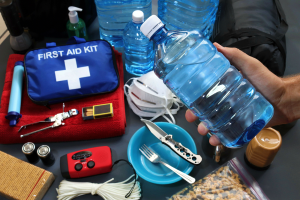
- Long Term Food: Opt for non-perishable items like canned goods, granola bars, and dried fruits. Don’t forget a manual can opener.
- Medications and First Aid: Include a well-stocked first aid kit, prescription medications, and any necessary medical supplies.
- Shelter and Clothing:
- Shelter: Have a tent, sleeping bags, or emergency blankets to provide shelter during evacuation or emergencies.
- Clothing: Pack durable clothing suitable for various weather conditions, including rain gear, warm layers, and sturdy shoes.
- Tools and Supplies:
- Flashlights and Batteries: Keep several flashlights with extra batteries readily available.
- Multi-Tools: A versatile tool that combines various functions like pliers, a knife, and a screwdriver can be indispensable.
- Whistle and Signal Mirror: These can help attract attention if you’re lost or need to signal for help.
- Duct Tape and Plastic Sheeting: These items can be used for temporary repairs and improvisation.
- Cash: Keep a small amount of cash in case ATMs are unavailable during a disaster.
- Communication and Documentation:
- Battery-powered or Hand Crank Radio: Stay informed about the latest news and emergency updates.
- Cell Phone Charger: Have a portable charger or a solar-powered charger to keep your cell phone operational.
- Important Document Storage: Gather important documents like identification, insurance policies, and contact information in a waterproof container.
- Personal Hygiene and Sanitation:
- Personal Hygiene Items: Include items such as toothbrushes, toothpaste, hand sanitizer, and feminine hygiene products.
- Sanitation Supplies: Stock up on toilet paper, trash bags, and disinfectant wipes to maintain cleanliness.
- Additional Considerations:
- Pet Supplies: If you have pets, include food, water, medications, and any necessary documents.
- Entertainment and Comfort: Include books, playing cards, or other small games to keep spirits high during stressful times.
- Emergency Contact List: Write down important phone numbers and addresses in case your electronic devices are not accessible.
Reliable Resources:
- Ready.gov: The official website of the U.S. Department of Homeland Security provides comprehensive information on disaster preparedness.
- American Red Cross: Visit redcross.org for a wealth of resources, including emergency planning guides and first aid tips.
- FEMA: The Federal Emergency Management Agency offers valuable guidance on disaster preparedness and response at fema.gov.
Building a disaster kit is an essential step in preparing for emergencies. By following the practical tips, actionable advice, and utilizing reliable resources provided in this guide, you can create an ultimate disaster kit that will help you and your loved ones stay safe and resilient during challenging times. Remember to regularly check and update your kit to ensure its effectiveness. Being prepared is the key to successfully navigating through any disaster or emergency.
Why Emergency Personnel Safety Equipment Must Be High-Quality
February 4, 2023 by Guest Author
Filed under General Emergency Supplies
When flying in an airplane, if an emergency occurs, it is important to place the oxygen mask over your own face before you assist someone else. This is because if you are attempting to help another person but faint due to lack of oxygen, you will do them no good. In much the same way, rescue workers need proper safety equipment when they work to assist citizens. If they do not have the proper equipment, their ability to lend aid becomes limited. Therefore, it is imperative they are provided with high-quality safety gear.
Harnesses:
Rescue workers require high-quality harnesses when performing rescues. For example, the brave people who risk their lives hanging from helicopters in an attempt to pluck some wayward soul from raging floodwaters require proper safety harnesses in order to perform their life-saving job.
Ropes:
Another piece of necessary equipment is a well-made rope. Many accident scenarios require rescue workers to use a rope when aiding another person. When workers are in harnesses, they sometimes use ropes as a safety line in order to remain safe.
Connectors and hooks:
The harnesses and ropes are great, but without connectors and hooks, they are useless. Connectors keep rescue workers firmly attached to their harnesses and allow them to hook on victims as they assist them.
Jackets:
A rescue worker’s visibility to those around them is very important. For example, a worker aiding in the event of an accident should wear a reflective coat or vest to make themselves easily visible to victims.
Flashlights:
There are many varieties of rescue work, and almost all of them will benefit from a high-quality flashlight. After natural disasters, first responders are likely to deal with power outages. A good flashlight will prove invaluable in such a situation.
Radios:
Communication is vital among rescue workers. Creating a calm and controlled environment is one of the first priorities of rescue personal. Knowing the location of other rescue workers or coordinating rescue efforts is also imperative.
Hard hats or helmets:
In some situations, rescue personal would benefit from hard hats or helmets. Helmets are often worn by emergency workers. Many of them have protection for the eyes built-in. Hard hats are necessary on any sites where the potential of falling debris exists.
Rescue workers serve their communities selflessly. High-quality safety gear keeps them safe as they seek to keep us safe. If their equipment is old or worn out, workers become limited in their rescue performance. For that reason, all rescue workers require high-quality safety gear for any job that presents itself.
Eric Blair writes about construction safety and the importance of having proper equipment from a reputable dealer like Fall Protection USA.
Emergency Seed Supplies for a Disaster
February 3, 2023 by admin
Filed under Food Supplies, General Emergency Supplies
Growing your own food can be a valuable source of nutrition and security during an emergency, but access to seeds can be limited. It is important to have a stockpile of emergency seed supplies to ensure that you have the necessary materials to start a vegetable garden when the time comes.
When selecting emergency seed supplies, it is important to choose seeds that are easy to grow, have a high yield, and are versatile in terms of their uses. Some good options include:
- Leafy greens: Leafy greens like lettuce, spinach, and kale are quick-growing, nutritious, and can be used in a variety of dishes.
- Root crops: Root crops like carrots, beets, and turnips are easy to grow and store, making them an excellent choice for an emergency seed supply.
- Squash: Squash plants are hardy and produce a large yield, making them a great option for an emergency seed supply.
- Tomatoes: Tomatoes are a staple in many diets and can be used in a variety of dishes, making them an important part of any emergency seed supply.
 When storing your emergency seed supplies, it is important to keep them in a cool, dry place to ensure their viability. Consider using airtight containers or vacuum-sealed bags to help protect your seeds from moisture and temperature fluctuations.
When storing your emergency seed supplies, it is important to keep them in a cool, dry place to ensure their viability. Consider using airtight containers or vacuum-sealed bags to help protect your seeds from moisture and temperature fluctuations.
In addition to selecting and storing your seed supplies, it is also important to have a plan in place for starting and maintaining a garden during an emergency. This may include access to tools, water, and soil, as well as a plan for protection from animals and insects.
Having a stockpile of emergency seed supplies can provide peace of mind and ensure that you have access to fresh, nutritious food in the event of a disaster. By selecting easy-to-grow, high-yielding crops, and properly storing your seed supplies, you can ensure that you have the necessary materials to start a vegetable garden during an emergency.
Picking the Right Generator for an Emergency
February 1, 2023 by admin
Filed under General Emergency Supplies
In emergency situations, having a reliable source of power can mean the difference between safety and chaos. Generators are one of the most effective solutions to provide backup power during outages, natural disasters, and other emergency events. However, not all generators are created equal. Choosing the right generator for your needs can be a daunting task, but it is essential to ensure that you have the best equipment to meet your needs in a crisis.
There are two main types of generators: portable and standby. Portable generators are smaller and can be moved from place to place, making them ideal for outdoor activities, camping trips, and emergency backup power. Standby generators are larger and are typically permanently installed outside the home or business. They automatically turn on when the main power goes out and are ideal for those who require constant and reliable power.
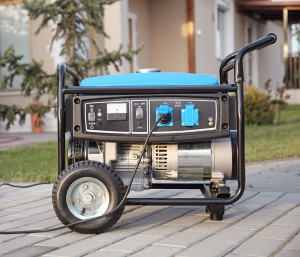 When choosing a generator, the first consideration is the type of fuel that the generator uses. There are three main types of fuel: gasoline, propane, and diesel. Gasoline is the most commonly used fuel for portable generators, as it is readily available and relatively cheap. Propane is a clean-burning fuel that is easy to store and transport, making it an excellent choice for backup power in emergency situations. Diesel is a more expensive fuel option, but it is more efficient and has a longer lifespan than gasoline.
When choosing a generator, the first consideration is the type of fuel that the generator uses. There are three main types of fuel: gasoline, propane, and diesel. Gasoline is the most commonly used fuel for portable generators, as it is readily available and relatively cheap. Propane is a clean-burning fuel that is easy to store and transport, making it an excellent choice for backup power in emergency situations. Diesel is a more expensive fuel option, but it is more efficient and has a longer lifespan than gasoline.
The next consideration is the generator’s power output. Generators are rated by the amount of power they can produce, measured in watts. The amount of power you need will depend on what you plan to run on the generator, including lights, appliances, and tools. Consider the total power requirement of all the devices you plan to run, and choose a generator that can handle that amount of power.
Another important factor to consider is the generator’s fuel efficiency. This refers to the amount of fuel the generator uses to produce a certain amount of power. The more fuel-efficient the generator, the longer it can run on a single tank of fuel, making it more practical in emergency situations.
The generator’s noise level is also an important factor to consider. In emergency situations, you may need to use the generator at night, so it is important to choose a generator that operates quietly to avoid disturbing your neighbors.
Ease of use and maintenance is another critical factor. Portable generators should be easy to start and operate, with clear instructions and safety features. Standby generators should be easy to install and maintain, with readily available parts and support.
Finally, it is important to choose a generator that is safe and reliable. Look for generators that are certified by organizations such as Underwriters Laboratories (UL) or the American Gas Association (AGA) to ensure that they meet safety standards.
Choosing the right generator for your emergency needs requires careful consideration of several factors, including the type of fuel, power output, fuel efficiency, noise level, ease of use and maintenance, and safety and reliability. Take the time to research your options and choose a generator that meets your needs and provides peace of mind during an emergency.
Use of Iodide in a Disaster: How and Why to use it
January 31, 2023 by admin
Filed under General Emergency Supplies
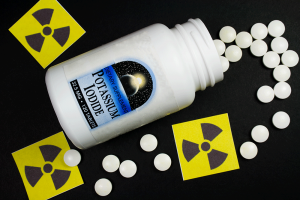 Iodide is a crucial element that plays a significant role in maintaining human health during disaster situations. The element is used to prevent the absorption of radioactive iodine by the thyroid gland, which can cause severe health problems such as radiation sickness, cancer, and thyroid disorders.
Iodide is a crucial element that plays a significant role in maintaining human health during disaster situations. The element is used to prevent the absorption of radioactive iodine by the thyroid gland, which can cause severe health problems such as radiation sickness, cancer, and thyroid disorders.
In a disaster situation, radioactive iodine can be released into the air, water, and soil due to nuclear accidents or the detonation of nuclear weapons. When inhaled or ingested, radioactive iodine can be absorbed by the thyroid gland, leading to long-term health consequences.
To prevent the absorption of radioactive iodine, iodide is used in the form of potassium iodide (KI) or sodium iodide (NaI). These iodide salts are taken orally and help to saturate the thyroid gland, preventing the uptake of radioactive iodine.
One of the key reasons for using iodide in disaster situations is that it is a simple and effective way to protect the thyroid gland. Unlike other protective measures, such as evacuation or sheltering in place, iodide can be taken quickly and easily, making it a reliable option in emergency situations.
Iodide is also readily available and affordable, making it an accessible option for people in disaster-stricken areas. Additionally, iodide is well-tolerated by the human body and has been used for decades as a dietary supplement to prevent iodine deficiency.
However, it is important to note that iodide is not a cure-all solution and should not be relied upon as the sole means of protection against radioactive iodine. Iodide is most effective when taken before or immediately after exposure to radioactive iodine. Therefore, it is essential to have access to iodide as soon as possible after a disaster event.
In addition to being used for individual protection, iodide can also be used in a larger scale in disaster situations. For example, iodide can be added to public water supplies to protect the entire population from exposure to radioactive iodine.
In order to maximize the effectiveness of iodide in a disaster situation, it is crucial to have a well-planned and coordinated response. This includes having adequate supplies of iodide on hand, clear communication channels to disseminate information to the public, and trained personnel to manage the distribution and administration of iodide.
It is also important to consider the specific needs of different populations, such as children, pregnant women, and those with underlying medical conditions. For example, children may require lower doses of iodide compared to adults, and pregnant women may need to take additional precautions due to the potential risks to the developing fetus.
In conclusion, iodide is a critical component of emergency preparedness and response in disaster situations. Its ability to prevent the absorption of radioactive iodine by the thyroid gland makes it a simple and effective means of protecting human health. However, the effective use of iodide in disaster situations requires careful planning, coordination, and consideration of the specific needs of different populations.
Emergency Generator with Wheel Kit
March 19, 2012 by admin
Filed under General Emergency Supplies
Looking for a portable generator that includes a wheel kit? The DuroMax Gas Powered Generator offers a wheel kit to boost the portability aspect, yet still has 4,400 watts for your electric needs.
This baby boast a 4 gallon gas tank and runs about eight hours. It uses an electric key to start it and includes a battery, and it also has an automatic low-oil shut off. It’s quite handy.
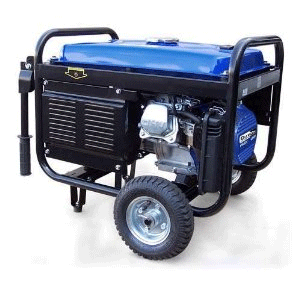 Even though it can reach 4400 watts, it runs continuously at 3500 with the 7.0 horsepower air-cooled OHV engine. The heavy-duty steel frame roll cage has a four-point fully isolated motor mount. It also includes a one-year limited warranty, which is nice.
Even though it can reach 4400 watts, it runs continuously at 3500 with the 7.0 horsepower air-cooled OHV engine. The heavy-duty steel frame roll cage has a four-point fully isolated motor mount. It also includes a one-year limited warranty, which is nice.
DuroMax 4,400 Watt 7.0 HP OHV 4-Cycle Gas Powered Portable Generator with Wheel Kit and Electric Start
Propane Powered Portable Generator
March 19, 2012 by admin
Filed under General Emergency Supplies
Need a portable generator that can run up to 10 hours with just 20 pounds of fuel? A propane powered generator lasts longer—and the fuel is less expensive—than a gas-powered generator.
This Sportsman 4,000 Watt Propane generator features an engine with 7 horsepower OHV. The generator itself offers two 120-volt AC outlets and one 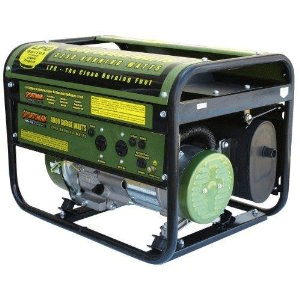 12-volt DC outlet.
12-volt DC outlet.
This little generator is perfect when you want to go camping, or if there is an emergency and the power goes out. It’s perfect.
Sportsman 4000 Watt 7HP OHV Propane Powered Portable Generator
4,000 Watt Gas Powered Emergency Generator
March 19, 2012 by admin
Filed under General Emergency Supplies
Looking for a powerful portable generator? The DuroStar 4000 watt generator offers long-lasting power with a 7.0 horsepower air-cooled overhead valve engine. It can last up to eight hours and offers a 4-gallon fuel tank, which makes this device a little heavier than other portable generators but it cranks out more voltage and watts.
It has a recoil start, a quiet muffler, and an automatic low-oil shutoff. It includes a tool kit and operation instructions directly from the box.
The generator has two 120-volt, 20-amp, 3-prong outlets to plug things into, as well as a 120-volt, 30-amp outlet for high-power tools.
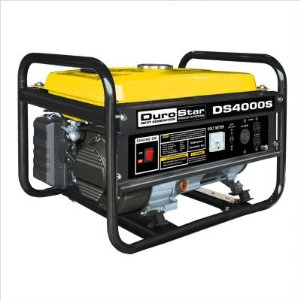 This generator is great in case there is an emergency and the power goes out. We rely so heavily on electricity that you need one, just in case!
This generator is great in case there is an emergency and the power goes out. We rely so heavily on electricity that you need one, just in case!
DuroStar DS4000S 4,000 Watt 7.0 HP OHV 4-Cycle Gas Powered Portable Generator
Portable 4-Stroke Emergency Generator
March 19, 2012 by admin
Filed under General Emergency Supplies
Humanity is dependent on electricity and power. So what happens if your area loses power during an emergency or natural disaster?
Many people invest in a portable generator, and this one is lightweight and portable, perfect for camping or for an emergency kit. The All Power America boasts 2,000 watts and uses a 4-stroke engine. This does away with the oil and gas mixture 2-stroke engines require, so it’s less of a hassle on you.
It can last for a total of nine hours off of 1.32 gallons of unleaded gasoline, making this generator easy to use and easily transportable. It has 3 horse power and gives off 122.5 volts, 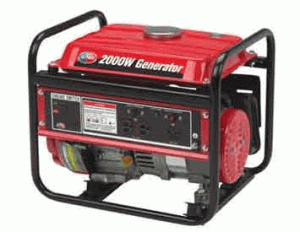 which is handy.
which is handy.
All Power America 2,000 Watt 4-Stroke Gas Powered Portable Generator
Lightwight Emergency Stove
December 21, 2011 by admin
Filed under Food Supplies, General Emergency Supplies, Survival Tools
When you need to go, be prepared! One of the major elements you need to keep in mind is food: how are you going to get it? Or cook it? That’s why little lightweight s toves like this one, the Wetfire Stove, is great as an addition to any emergency disaster kit or camping pack.
toves like this one, the Wetfire Stove, is great as an addition to any emergency disaster kit or camping pack.
This stove only weighs half an ounce; it folds up to store nicely. The fuel are cubes that won’t spill in your bag or cause accidental fires. It can boil a cup of water in 5-6 minutes.
Not only can you use it for cooking food while you’re trying to survive, but you can sterilize water by boiling it. It’s handy to have something like this when a disaster strikes.










